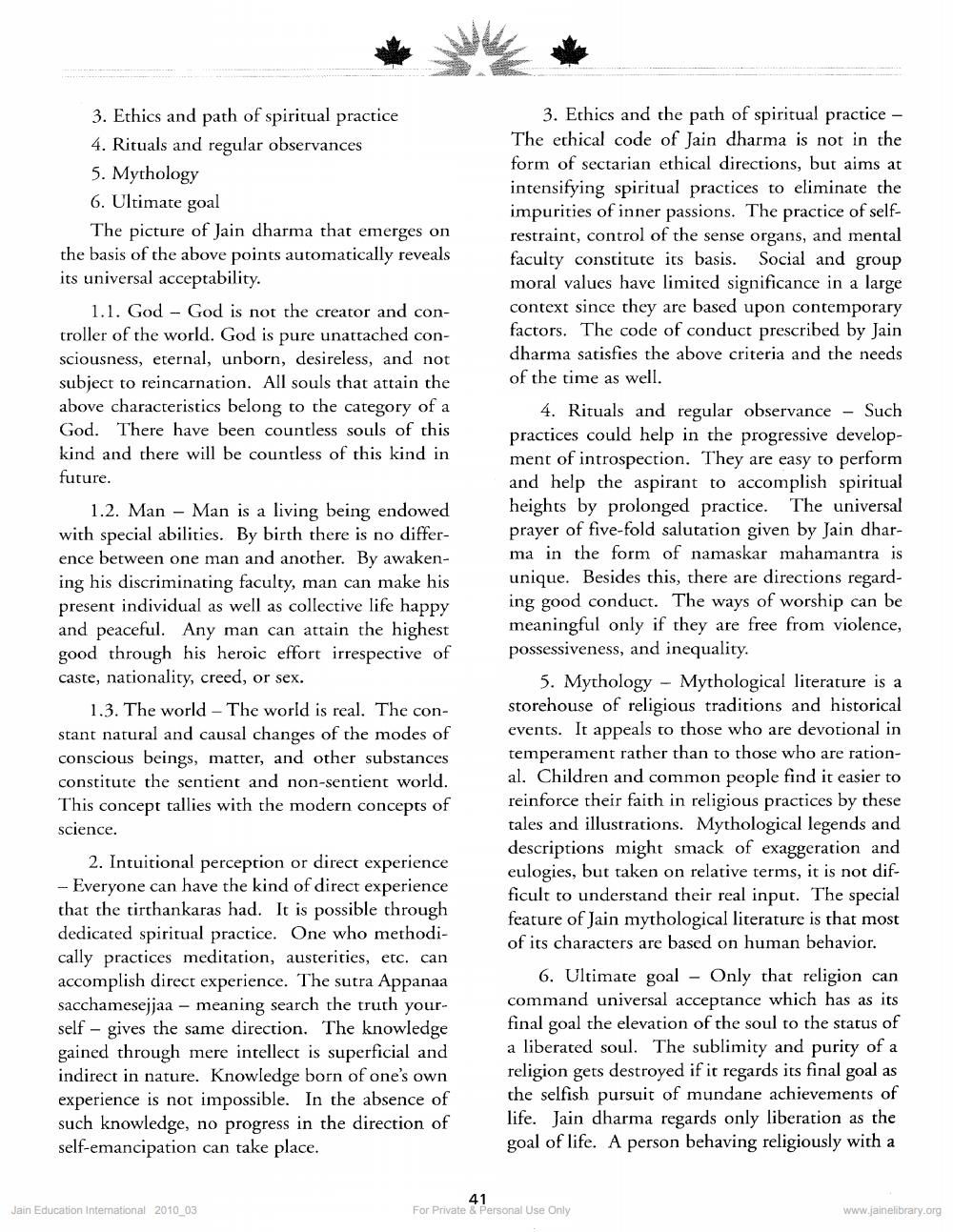________________
3. Ethics and path of spiritual practice 4. Rituals and regular observances.
5. Mythology
6. Ultimate goal
The picture of Jain dharma that emerges on the basis of the above points automatically reveals its universal acceptability.
1.1. God God is not the creator and controller of the world. God is pure unattached consciousness, eternal, unborn, desireless, and not subject to reincarnation. All souls that attain the above characteristics belong to the category of a God. There have been countless souls of this kind and there will be countless of this kind in future.
1.2. Man - Man is a living being endowed with special abilities. By birth there is no difference between one man and another. By awakening his discriminating faculty, man can make his present individual as well as collective life happy and peaceful. Any man can attain the highest good through his heroic effort irrespective of caste, nationality, creed, or sex.
1.3. The world - The world is real. The constant natural and causal changes of the modes of conscious beings, matter, and other substances constitute the sentient and non-sentient world. This concept tallies with the modern concepts of science.
2. Intuitional perception or direct experience - Everyone can have the kind of direct experience that the tirthankaras had. It is possible through dedicated spiritual practice. One who methodically practices meditation, austerities, etc. can accomplish direct experience. The sutra Appanaa sacchamesejjaa - meaning search the truth yourself- gives the same direction. The knowledge gained through mere intellect is superficial and indirect in nature. Knowledge born of one's own experience is not impossible. In the absence of such knowledge, no progress in the direction of self-emancipation can take place.
Jain Education International 2010_03
3. Ethics and the path of spiritual practice - The ethical code of Jain dharma is not in the form of sectarian ethical directions, but aims at intensifying spiritual practices to eliminate the impurities of inner passions. The practice of selfrestraint, control of the sense organs, and mental faculty constitute its basis. Social and group moral values have limited significance in a large context since they are based upon contemporary factors. The code of conduct prescribed by Jain dharma satisfies the above criteria and the needs of the time as well.
4. Rituals and regular observance - Such practices could help in the progressive development of introspection. They are easy to perform. and help the aspirant to accomplish spiritual heights by prolonged practice. The universal prayer of five-fold salutation given by Jain dharma in the form of namaskar mahamantra is unique. Besides this, there are directions regard ing good conduct. The ways of worship can be meaningful only if they are free from violence, possessiveness, and inequality.
5. Mythology Mythological literature is a storehouse of religious traditions and historical events. It appeals to those who are devotional in temperament rather than to those who are rational. Children and common people find it easier to reinforce their faith in religious practices by these tales and illustrations. Mythological legends and descriptions might smack of exaggeration and eulogies, but taken on relative terms, it is not difficult to understand their real input. The special feature of Jain mythological literature is that most of its characters are based on human behavior.
6. Ultimate goal Only that religion can command universal acceptance which has as its final goal the elevation of the soul to the status of a liberated soul. The sublimity and purity of a religion gets destroyed if it regards its final goal as the selfish pursuit of mundane achievements of life. Jain dharma regards only liberation as the goal of life. A person behaving religiously with at
41
For Private & Personal Use Only
-
www.jainelibrary.org




